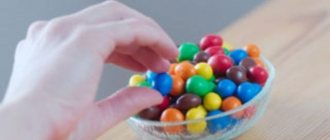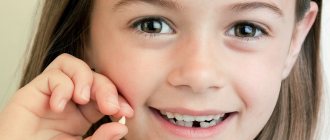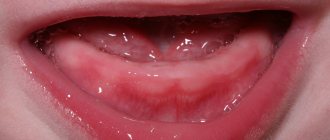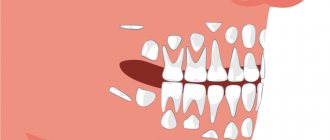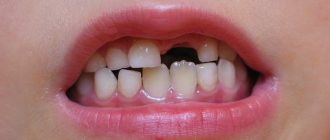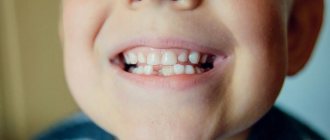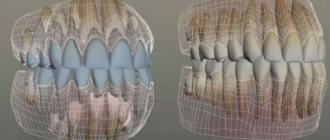Despite the widespread use of digital technologies, in the modern world there is still a place for folk signs, customs, and superstitions. A special place among them is occupied by stories related to children's milk teeth. For example, when the first incisor appears, it was customary for many nations to give a child a silver spoon and be sure to tap it on the emerging tooth. This meant that the baby was ready to meet adult food. Moreover, it was necessary to feed him with this silver spoon. Many signs are associated with their loss.
We’ll tell you where to put baby teeth and whether they can be stored in our article. We will definitely dwell on the interesting signs and traditions of the peoples of the world that have survived to this day.
When does baby teeth change?
The moment when a baby’s lower incisors, as a rule, begin to loosen, can safely be called one of the most exciting in the lives of both children and their parents. Typically, a child's first tooth falls out at the age of 6-7 years. This time for most children coincides with the beginning of school life. This is where the first sign came from: the first tooth fell out, which means it’s time to go to school.
Do not worry too much if the change from milk units to permanent ones does not occur within the generally accepted time frame. They may vary depending on the individual characteristics of the child, the development of his jaw, and the condition of the oral cavity. In this regard, some children begin to lose teeth at the age of five, while others after seven.
Most often, the loss of milk units is preceded by the growth of “sixes”. First, the lower incisors begin to loosen, then the upper ones. That is, their change occurs in the same sequence as growth. So parents have enough time to figure out where to put their baby teeth.
A sign if an adult has a baby tooth
The loss of baby teeth in adults always predicts trouble.
Contrary to the ridicule of ignorant people, baby teeth in adults are not at all uncommon. They can persist for a long time. In some cases - all your life. The anomalous phenomenon is explained by the absence of the rudiments of permanent incisors. This can also happen when they are too deep from the roots of milky specimens. In this case, the incisors cannot push them out and remain inside the gums.
Inadequate development of permanent teeth can be caused by:
- hormonal imbalances;
- hereditary factor;
- disruption of the endocrine glands;
- osteomyelitis of the jaw;
- periodontitis.
It is not at all necessary to part with dairy specimens. If they do not cause concern, there is no need to remove them; they can last for decades.
The loss of baby teeth in an adult always indicates the presence of health problems. Dentists confirm this by recommending an examination of the body.
Superstitions on this score also have exclusively negative interpretations. Among them:
- exposure to other people's negative energy;
- weakening of the aura or a hole in it;
- betrayal of family and friends;
- betrayal, divorce.
Due to the negative consequences, fallen teeth of an adult should not be stored. They are buried or burned, destroying the negative.
Parents' actions when changing primary incisors
Dentists assure that a child whose first teeth are becoming loose does not need pain relief for this process. Although some parents think differently. In fact, before a tooth begins to loosen, its roots dissolve. But discomfort and pain can be caused by a wound formed at the site of a fallen tooth.
Parents of a child whose first tooth has just fallen out can help by:
- Explain that the process of loss is another stage of growing up. Now the child has become very big and can be proud of it.
- Take care of your oral hygiene by rinsing your mouth with a soda solution.
- Warn the child that the wound formed at the site of a lost tooth should not be touched with hands, so as not to cause an infection.
- After eating, suggest rinsing your mouth with warm water. Do this until the wound heals.
What do signs and traditions say?
Curious signs and legends about children's teeth:
- A child born with teeth is a sign that he will have a special gift associated with magic and clairvoyance.
- Too early appearance of a tooth means the birth of a younger sister or brother in the near future.
- If the top one appears first, a brother or sister will be born sooner than in a year.
- Late appearance, according to signs, promises prosperity and a rich future for the tomboy.
- If the cutting takes a long time and the process is poorly tolerated, then your beloved child will be very capricious in the future and a difficult character will be formed.
- After the first tooth appears, parents should give the child a silver spoon as a gift.
- The baby often squeaks with them while eating - a bad omen, promising unpleasant events and minor illnesses in the near future.
- A pronounced gap in the front is a good sign, promising a cheerful character, the absence of serious problems in life, as well as love. If you can insert a coin sideways into the gap, then this is a sign of wealth.
- According to signs, you can speed up the process of teething with the help of talismans made by the mother herself from corals and seashells.
- A wolf fang, which the child must gnaw, can relieve pain.
- If a child’s tooth breaks or crumbles into large pieces, it means that the baby will soon become seriously ill.
- Accidentally knocking it out means successful learning and early discovery of talents.
- Growing up small and clinging closely together is a bad sign, indicating that in the future the child will be greedy and stubborn.
- When your firstborn turns one year old, you need to count your grown teeth. The resulting number is equal to the number of offspring in the family that will appear over the years of marriage.
Do I need to see a doctor?
Ideally, when baby teeth are replaced, they fall out on their own, meaning no removal is required. But in 80% of cases everything turns out a little differently. The permanent tooth begins to emerge after the milk tooth, when it has not yet fallen out. And since he encounters an obstacle on his way, he changes his direction in the wrong direction. Subsequently, this leads to the formation of an incorrect bite in the baby.
To help the baby tooth leave its place faster and free up the permanent one, you need to consult a doctor. Only a competent specialist can surgically remove a unit of dentition correctly. If you try to do this yourself at home, you can damage the gum mucosa and provoke the development of an inflammatory process. You may also need the help of a dentist in the following atypical situations:
- with swelling and severe pain in the gums;
- with bleeding and long wound healing;
- when a tooth is broken or severely damaged;
- in case of ingestion of a unit of the series.
As soon as a child’s tooth begins to loosen, he is most often in high spirits. Very soon the child will be able to show off to his friends how grown up he has become. At this very moment, parents are overcome by another problem, namely, where to put their baby teeth. You should think about this in advance.
Superstitions about the first tooth
First tooth
The appearance of the first tooth most often occurs between 4 and 6 months of a child’s life. If the first tooth grew earlier, signs and customs promised the mother the next pregnancy. It had to come very quickly if the tooth grew first from above. There were other beliefs about the time of the appearance of the first teeth.
Free Online Tarot Course Eliminate 10 Key Beginner Mistakes and Start Reading Tarot Cards with Ease Without Any Prior Knowledge
GET ACCESS
Tarot and Money 5 steps from love for cards to financial independence from the founder of the Russian Tarot School Sergei Savchenko
FREE SEAT
Runes without fear and energy consumption How to use Runes correctly? Receive 3 gifts that will help you quickly apply Runes to achieve your goals
I WANT A PRESENT
In some regions, late teething was considered a special sign. They believed that the first tooth after 7 months is a sign of a child’s giftedness, gifted from above. In other places, on the contrary, they believed in omens that called the early eruption of the first tooth a sign of striking originality.
If it takes too long to cut the first tooth, signs predict problems for those around you with this child. He will be capricious and disobedient. If all his teeth take too long to cut and cause both the baby and the parents a lot of anxiety, then even as an adult he will not have an easy-going disposition. Such kids grow up to be bores, always annoying their loved ones with their whining.
Folk omens consider the following to be the most dangerous signs:
- the appearance of the first tooth or teeth in the womb;
- when the upper canine or upper canines grow first.
These signs about teeth are considered frightening because they threaten the baby with imminent death. There is another interpretation - service to the dark forces, to which the child will devote himself when he becomes an adult. This sign extended first of all to those who first had a large fang.
When a baby's tooth grows, omens advise godparents to give him a silver spoon. It was necessary to tap the tooth with a spoon so that it would grow strong. Then all the others will grow up quickly and will never get sick. This sign raises many doubts and questions. After all, ancient beliefs required a silver spoon from the godfather as a christening gift. And then they tapped the gums with that spoon to check whether the tooth had already appeared or not. It was silver that was needed because it is the safest material in terms of limiting the growth of bacteria.
To protect your baby from evil spirits at a difficult moment in his life, it is better to take care of an amulet that can protect him from harm. Of course, the most reliable remedy is mother’s hands and her kind energy. To make teething go smoothly, shells, coral beads or amulets containing red ribbons were hung from the cradle. And the baby was allowed to gnaw on a wolf's fang or suck on a silver spoon given by his godparents. The first person to notice the emerging tooth owes the baby a gift.
In Armenia, the day of the first tooth erupting is celebrated in a special way. They organize a big celebration where they guess what the baby will become when he grows up. To do this, objects symbolizing the main professions are laid out around the child. Whatever he chooses, that is what he is destined to become. For example, the steering wheel is the driver’s and so on.
Where to put a lost baby tooth?
As you know, in most children the lower primary incisors are the first to leave the dentition. And even if this event did not happen at home, but in a dental clinic, the doctor is obliged to give the child his tooth. And already at home, mom and dad will decide for themselves what to do with the child’s fallen baby teeth. But most parents don’t dare throw it in the trash.
Many mothers carefully store objects that remind them of the first years of their baby's life. These include an ultrasound picture taken during pregnancy, a tag from the maternity hospital, and the first curl cut at 1 year. It is along with these things that most mothers prefer to store the first tooth that falls out.
If parents are superstitious enough, they can conduct a real ritual of farewell to the milk element with their child, which he will remember for the rest of his life and will be able to pass on this tradition to his children. To do this, you should get acquainted with the signs of different peoples of the world in advance.
When do you need a doctor?
Usually, replacing baby teeth with permanent ones occurs painlessly in children. Often, having lost a tooth while playing, kids give them to their parents and forget about them. Some people ask not to throw it away, because it will be very interesting to play with it later. But in some cases, the help of a doctor is necessary. In what?
- If the permanent ones are already making their way out, but the milk ones have not yet fallen out.
- When permanent teeth take too long to emerge.
- If tooth sockets bleed for too long.
- When, after a tooth falls out, the gums become swollen and painful.
Note! When your child turns 5, check his mouth regularly to make sure his permanent teeth are still in place. If this process begins before their temporary replacements fall out, the dentition will be crooked. In this case, eating solid foods will help. In some cases, the help of a dentist is required.
In general, the replacement of baby teeth with permanent ones occurs without any problems. Of course, parents should periodically examine the child's mouth and monitor his emotional state. If everything goes according to plan, and the baby perceives the situation calmly, there is no need to worry. It’s up to the parents to decide where to put their baby’s lost baby tooth. Some keep it as a memory, others use it as a talisman, others throw it away and forget about it. Many mothers and fathers stage entire theatrical performances to make this event interesting for the baby and remain in his memory for a long time.
Is it possible to store baby teeth?
Until recently, it was believed that elements of the dentition that had fallen out independently or surgically removed should be immediately disposed of. Black magicians, witches and sorcerers could steal them from home and plot or damage them. That's why parents didn't stand on ceremony about where to put their baby teeth. They were thrown away or buried deep in the ground.
Today, the opinion about methods of disposal of fallen baby teeth has changed dramatically. The fact is that British scientists have learned to extract stem cells from pulp. It has been proven that their potential is much stronger than biomaterial taken from the umbilical cord of a newborn. To find out more about this, parents can contact a stem cell storage bank. Biomaterial is stored in this medical institution at a temperature of -196 °C. Frozen cells can later be used in the treatment of serious diseases, including bone marrow transplantation.
Wisdom teeth in popular beliefs
According to legend, the owner of all wisdom teeth is given the opportunity to use the help of his ancestors, so it is easier for him to do everything. Ancient signs call wisdom teeth a lucky sign, foreshadowing wealth, success, and good luck. Moreover, pain and other unpleasant sensations during their eruption were also considered additional happy signs. To preserve molars, they used special rituals to preserve their health and strength.
If a molar was lost in battle or a fight, it was kept as a talisman. The gypsies buried it and waited for wealth to descend on them.
People who never received one or more wisdom teeth may first decide that they are very unlucky. But this happens often today. After all, the jaw of a modern person is narrower than in ancient times.
What to do with a child’s baby teeth: folk signs
From time immemorial, each nation has had its own traditions and customs regarding the storage of fallen child teeth. For example, nomadic tribes always buried them. Therefore, there were no questions about what to do with the child’s baby teeth. The parents had to dig a deep hole, put the tooth in it and cover it with earth. It was believed that this was the only way to protect the baby from damage and misfortune.
The peoples of Britain had their own traditions regarding where to place a child's baby teeth. Folk customs boiled down to preventing damage to a child using a tooth. For this purpose, any milk element of the row was burned immediately after falling out. It was believed that in this case a strong and healthy one would quickly grow in its place.
Another sign common among the British in ancient times is associated with animals. It was believed that the tooth should be destroyed, hidden or buried so that a predator would not get it and eat it. If this happens, the child will grow fangs, like an animal.
Today all these signs seem strange and funny, but our ancestors sincerely believed in them and, worried about the fate of their children, unquestioningly carried out all these actions.
Can I just throw it away?
If you simply throw out the first baby tooth, your baby will suffer from insomnia
According to superstitions, this should not be done. It has been noticed that if you simply throw out the first baby tooth, the baby will suffer from insomnia, and new ones will grow incorrectly.
Folk omens strongly advise against neglecting lost baby teeth. In recent times, it was customary to collect all the teeth that fell out during life (they were then buried with the person after his death).
According to legend, you need to present them in the afterlife. In case of shortage, the soul will have to return to the real world in search. From a practical point of view, baby teeth are a storehouse of stem cells that can save a person’s life. But there are other reasons.
Another sign warns: if the tooth falls into the possession of any animal, then the person will have animal fangs.
And from real superstitions it follows that a grown-up child will move far and forever from his parents who neglected his first baby tooth that fell out.
Folk wisdom does not stop there, and offers a number of signs about the gap between the upper teeth:
- The presence of a gap in a child’s front teeth was a sign that the person was destined to become a merry fellow, a joker - they say about such individuals: “the life of the party.”
- When a gap appears in a child, this portends increased development of his intellectual abilities and speaks of a good character.
- Another interpretation of the gap between the teeth is a sign of an insidious person, prone to deceit, capable of deception.
- If a coin passes freely into the gap, this indicates a future rich man (English sign).
- The gap foreshadows poverty and an unhappy life (Chinese omen).
- Rare teeth are an indicator of an irresponsible and frivolous person.
- Small ones, who are cramped in their places, reveal a stingy person, characterized by increased “harmfulness”, who is also prone to often falling in love.
- Tooth decay (for a child or adult) is a harbinger of loss, or a warning that you are busy with an impossible task.
Most often, it is recommended to bury a lost baby tooth (not necessarily outside). A flower pot is suitable for this purpose.
Parting with dairy is stressful for the baby. To neutralize unpleasant feelings, parents come up with different stories and teach the child to “say goodbye” correctly.
Giving a milk tooth to a spirit, fairy, or mouse is an ancient tradition. If the baby gives away the loss in an organized manner, he should receive a gift. The purpose of this ritual is to support the child, create a special mood in him, and simply make him happy.
Give it to the fairy
This tradition was invented by Louis Colom, a writer of the 18th century. He composed a fairy tale for the young king of Spain when the high-ranking offspring lost his first milk at the age of 8. The story was about a fairy who picks up a baby’s fallen baby tooth under the pillow and leaves a nice gift in its place.
When telling all these fairy tales to your child, do not forget to add that whole teeth in good condition are valued more than damaged ones, and you can get better gifts for them. This way the child will be more willing to keep his mouth clean.
Pass to mouse
Our great-grandmothers also advised us to say: “Mouse, mouse, take away the milk tooth, and bring me a new one, bone and strong,” and throw it under the floor. Most likely, this sign is due to the fact that rodents have strong incisors, and the child will grow equally strong teeth.
And the appeal specifically to the mouse is due to the fact that these small animals were widespread in villages. They settled their homes under the floors and behind the stove. Therefore, the teeth were thrown into the oven or into the basement so that the mouse could surely discover the treasured gift.
This tradition (giving a tooth to a mouse) existed not only in Russia, but also in Germany and other European countries. And the Slavs, when they threw a fallen tooth into the stove, hoped that a brownie would pick it up.
Despite numerous traditions, when changing teeth, it is a good idea to consult a dentist
Why give a tooth to a mouse?
Among the Slavic peoples, one of the signs of where to put a baby tooth was associated with throwing the fallen unit behind the stove. This was done for a brownie or a mouse. They had to take the baby tooth and bring the molar tooth in return.
In some European countries, they also adhere to the custom of placing the tooth under the pillow at night. But it’s not the kind tooth fairy with wings and a magic wand in her hands who should take it, but a little mouse. In France she is called La Petite Souris, and in Spain - Perez. Traditionally, at night, an unnoticed little mouse sneaks under the pillow to exchange a tooth for money or treats. Children eagerly await the appearance of this rodent in order to receive something nice as a gift.
What are the dangers of early removal of baby teeth?
If a temporary tooth is forced to be removed before its natural loss by more than a year, then we are talking about early removal. This situation provokes malocclusion and improper development of the entire dental system, including delayed jaw growth.
Neighboring teeth strive to take the place of their distant counterpart, and all of them are displaced.
adjacent teeth and their roots, antagonist teeth also move into the resulting free space. As a result, permanent teeth can erupt chaotically and even outside the dentition. In the future, such a problem will require long-term orthodontic treatment.
In addition, earlier removal of chewing teeth leads to a redistribution of the load on the front teeth, which, in turn, begin to collapse.
Therefore, it is so important to strive to keep all baby teeth in their places for as long as possible, preferably until the time of their natural replacement.
Who is the tooth fairy?
In many countries of Northern Europe, America and Canada, they adhere to a different sign about a child’s baby teeth. People here know where to put the dropped element of a row almost from birth. Kids eagerly wait until their tooth begins to loosen so that after it falls out, they can put it under their pillow. In return, the good fairy should bring a coin there. This tradition is one of the most widespread and popular today. By the way, the fairy tale about the tooth fairy and the mouse Perez was invented by the Spanish writer Luis Coloma for the eight-year-old King Alfonso VIII, who lost his first baby tooth.
The myth of the good sorceress is a useful one. It helps the child overcome the fear of a lost tooth and allows him to receive monetary or other pleasant compensation for the loss.
"Dental" rituals
Even ancient parents thought about where to put a child’s baby tooth. Here are the solutions they found:
- Tooth Fairy. In many European countries and America, a “magical” solution to the problem with the help of “tooth fairies” has long been common. The parents put the fallen tooth under the pillow at night, and the next morning they take out a coin or a gift from the fairy. Children usually like this game.
- Burning a tooth. In England, superstitious parents in the past burned their children's lost teeth, fearing that someone would use them for witchcraft purposes. In addition, in their opinion, this protected the babies from the appearance of fangs in the place of the old incisors.
- Gift for a mouse. This funny and strange custom originated in Rus' and is still practiced in many families. The child clamps the “burdock” tooth in his fist, and then asks the mouse to replace it with a “bone” one and throws it behind his back.
- Tribute to the spirits. In addition to mice in Rus', milk teeth were picked up by perfume or brownies. The children made the same request to them as they did to the mouse, hoping that this would make their jaws stronger.
Today, to calm their children, parents most often resort to a fairy tale with a fairy or a mouse. However, children cope well with the loss of an incisor even without these fantastic stories. Often it is enough just to explain that what is happening to them is a normal part of the process of growing up and that soon strong adult teeth will appear in their mouth instead of temporary ones. Children always want to grow up quickly, so this explanation will calm them down.
Additional Information. Children's milk teeth are often unreasonably given great importance, believing that they are endowed with some kind of charm. So, some wives sew them into their husbands’ clothes so that they do not leave the family. Others wear them around their neck or in their pocket as a talisman. All this is nothing more than superstitions from the past.
Do you need a gift?
Regardless of where the mother decides to put her child’s baby teeth, where to put them or to throw them away altogether, it will be very good if she prepares some surprise for the baby. This will make it easier for him to bear the loss.
If a child puts a tooth under his pillow, the first thing he will do when he wakes up is check to see if the mouse or tooth fairy took his treasure. If yes, then a coin or present should appear in this place. This could be a book, a coloring book, a set of pencils, paints or markers. Parents should choose gifts that can easily fit under the pillow. If the gift is too large, then it will have to be placed next to it.
It is not recommended to give chocolate, sweets and other sweets. The tooth fairy cares about the health of children's teeth, so she should give them only useful gifts. And as you know, sweets quickly begin to deteriorate your teeth. It is better to put a coin under the pillow, and for it the child will buy what he likes.
Traditions of the peoples of Asia
In many Middle Eastern countries, children do not leave their lost tooth to a mouse or fairy. Instead, they throw it up towards the sun. It is believed that this will allow teeth to grow faster and stronger than before.
A similar sign of where to put a lost baby tooth is followed in Japan. To get a new one instead of the old one, you need to make a good straight throw. But the bottom tooth should be thrown up, and the top one down, that is, in the opposite direction.
Tooth on the roof
Throwing up fallen milk elements is a fairly common sign among many nations. But children in some countries strive precisely to throw a tooth onto the roof. This is done in Greece, Brazil, Ethiopia, and Sri Lanka. But in China, Korea, Vietnam and India, this is done only with the lower teeth, and the upper ones, on the contrary, are thrown under the bed or even hidden in cracks in the floor. And every baby knows where to put baby teeth.
You need to throw your teeth onto the roof so that a bird or squirrel can grab it faster. Then a new one will very quickly grow in its place. And a tooth under the bed, most likely, can easily be dragged away by a mouse.
What anesthesia is used to remove baby teeth in children?
If we are talking about removing a baby tooth that is already loose, without complications and signs of inflammation, then such removal does not require pain relief.
If a problematic baby tooth is removed or it sits firmly in the jaw, then local anesthesia is used for children, sometimes with sedation.
Tooth extraction under anesthesia (general anesthesia) is possible in special clinics where a team of anesthesiologists works. From a medical point of view, in most cases there is no need to remove baby teeth under anesthesia. This is usually due to the fear of the child and his parents. The use of anesthesia is justified only in cases of serious mental disorders or complex illnesses, because it has more dangers than benefits .
Maybe the tooth needs to be hidden?
Not everyone wants to give their lost treasures to an animal or some fairy-tale creature. In Nepal it is considered very bad luck if a bird takes a tooth and does something with it. In this country, children come up with their own secret storage places that even adults don’t know about.
In Malaysia, fallen milk teeth are also hidden, but only in the ground. The kids bury them, thus returning them back to nature.
In Turkey, parents believe that with the help of baby teeth they can influence their child’s choice of future profession. So, they bury the fallen elements near the hospital if they want their child to be a doctor, or near the school if they dream of seeing him as a teacher. Football fields are especially popular.
How to properly prepare a child for tooth extraction in pediatric dentistry?
- A brave child is one who is familiar with the place and situation, so parents need to try to ensure that the first visit to the dental clinic is not associated with treatment, much less tooth extraction and pain. Go with your child to the dental clinic for preventive examinations, children's parties, which we regularly hold, take your child with you when you go to have your teeth treated.
- A good, cozy clinic is not a dream today, but an accessible reality. Go to the clinic yourself without your child, meet the doctor. The atmosphere should be calm, the space should be thought out for small patients. And, of course, no screaming or crying behind office doors.
- Never frighten your child with the dentist or doctors in general, and do not be afraid of them yourself - children subtly sense the mood of their parents.
- Ask your doctor whether it is better to leave your child alone or be present during the procedure. NEVER leave your child alone at the dentist's office if this is their first appointment with the dentist.
- Do not shame your child in the dentist's chair, do not blackmail him with a gift or threaten him with punishment. Introduce him to the doctor and help establish contact between them, using the child’s natural curiosity - he should be interested, not scared.
